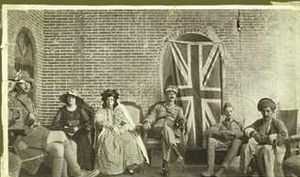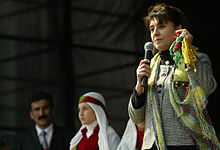Kurdish women
Kurdish women (Kurdish: Jinên/Afiretên Kurd) have traditionally played important roles in Kurdish history, society and politics.
.jpg)

Historical Accounts
In Politics
Sharaf ad-Din Bitlisi's 1597 Sharafnama mentions three Kurdish women assuming power in Kurdish principalities. Evliya Çelebi also noted that Kurdish women did occasionally assume power in Kurdistan and Ottoman authorities accepted the succession in those principalities by a female ruler.[1]
In the late 19th century, Lady Halima Khanim of Hakari was the ruler of Bash Kala until she was forced to surrender to the Ottoman government after the suppression of Bedir Khan revolt in 1847. A young Kurdish woman named Fatma became chief of the Ezdinan tribe in 1909 and she was known among her tribe as the queen. During the World War I, Russian forces negotiated their safe passage through tribal territory with Lady Maryam of the famous Nehri family, who according to Basile Nikitine, wielded great authority among her followers. Lady Adela, ruler of Halabja, exerted great influence in the affairs of Jaf tribe in the Shahrazur plain on the Turco-Iranian frontier. The revival of commerce and restoration of law and order in the region of Halabja is attributed to her sound judgement.[2]
In Society and Literature
According to the Kurdish writer Mahmud Bayazidi, the Kurdish women did not veil and they participated in social activities such as work, dancing and singing together with men.[3] In traditional Kurdish literature, both matriarchal and patriarchal tendencies are found. In the Ballad of "Las and Khazal" (Beytî Las û Xezal), female tribal rulers openly compete over a lover, while in patriarchal contexts, women are subject to male violence.[1]
Accounts of Western Travelers
European travelers sometimes noted the absence of veil, free association with males (such as strangers and guests), and female rulers.[4] Vladimir Minorsky has reported several cases of Kurdish women running the affairs of their tribes. He met one of these female chiefs named Lady Adela in the region of Halabja in 1913. She was known for saving lives of many British army officers during World War I and was awarded the title of Khan-Bahadur by the British commander.[5]
Kurdish Women in Syria
Kurdish female fighters in the YPJ (Women's Protection Units) played a key role in the defense of Kobani and in rescuing Yazidis trapped on Mount Sinjar, and their achievements have attracted international attention as a rare example of strong female achievement in a region in which women are heavily repressed.[6][7][8][9][10]
Kurdish Women in Iraq
The prominent Kurdish poet Goran denounced discrimination and violence against women. The first journal for Kurdish women, Dengî Afiret "Woman's Voice", was published in 1953. Following the overthrow of monarchy in 1958, the Union of Kurdish Women lobbied for legal reform in the Iraqi civil law and it succeeded in bringing marriage under civil control and abolishing honor killing. The first female judge in Middle East was a Kurdish woman named Zakiyya Hakki who was appointed by Abd al-Karim Qasim. She later became part of the leadership of KDP.[11]
During the Anfal campaign in 1988, Kurdish women were kept in concentration camps and rape was used as a form of punishment. In 1994, Kurdish women marched for peace from Sulaimaniya to Arbil and protested against the civil war in Iraqi Kurdistan.[1] After the establishment of KRG, women were able to form their own organizations and several women became ministers in the cabinet of local government. In September 2003, Nasrin Berwari was appointed to the 25-member Iraq provisional cabinet as minister of municipalities and public works, and in June 2004, she was among six women named to the 30-member transitional cabinet and in April 2005 was named permanently to that post. As the top Iraqi official in charge of municipal and environmental affairs, Berwari is considered as one of the most important figures in the Iraqi civil administration.[11]
Kurdish Women in Turkey

In 1919, Kurdish women formed their first organization, the "Society for the Advancement of Kurdish Women", in Istanbul.[12]
During the revolts of 1925-1937, the army targeted Kurdish women, many of who committed suicide to escape rape and abuse.[13] By the mid-1990s, thousands of women had joined the ranks of PKK, and the mainstream media began a campaign of vilifying them as "prostitutes". In 1996, Kurdish women formed their own feminist associations and journals such as Roza and Jujin.[14]
Leyla Zana became the first Kurdish woman elected to Parliament of Turkey in 1991. During her inauguration speech, she identified herself as a Kurd and spoke in Kurdish. She was subsequently stripped of her immunity and sentenced to 15 years in prison. She was recognized by Amnesty International as a prisoner of conscience and was awarded the Sakharov Prize by the European Union in 1995.
Eight Kurdish women stood successfully as independent candidates in the 22 July 2007 general election, joining the Democratic Society Party after they entered the Turkish parliament.
Kurdish Women in Iran
During World War I, Kurdish women suffered from attacks of Russian and Turkish armies. In 1915, Russian army massacred the male population of Mahabad and abused two hundred women. Reza Shah issued his decree for coercive unveiling of women in 1936. Government treated the colorful traditional Kurdish female custome as ugly and dirty and it had to be replaced with civilized (i.e. Western) dress. Kurds called this forced dress as Ajami rather than European.[15][16]
Republic of Mahabad encouraged women's participation in public life and KDPI launched a political party for women which promoted education for females and rallied their support for the republic.[17] In August 1979, the Iranian Army launched an offensive to destroy the autonomist movement in Kurdistan. Kurdish organizations such as Komala recruited hundreds of women into their military and political ranks. Within its own camps, Komala abolished gender segregation and women took part in combat and military training.
Over the years, Kurdish women assumed more roles in the Iranian society and by 2000, a significant number of Kurdish women had become part of the labor force, while an increasing number of females engaged in intellectual activities such as poetry, writing and music. On the other hand, domestic violence led many women to commit suicide, most commonly through self-immolation.[18][19]
Renowned Kurdish women
Asenath Barzani was among the first female rabbis in history. Mestureh Ardalan (1805–1848) was a Kurdish poet and writer. She is well known for her literary works. Lady Adela, Leyla Zana, Leyla Qasim, Professor Kajal Rahmani anthropologist, founder and president, Kurdistan Justice and Peace Academy in the US, champion for Kurdish rights and Feleknas Uca, are among the well known women for their role in the modern Kurdish and European politics.
Pêşmerge Women
Pêşmerge forces have a female combat unit called "The Pêşmerge Force for Women". Kurdish women have struggled hard to prove their worth as tough soldiers in a traditional society and they have earned a reputation for bravery and skill in the battlefield. While they were engaged in previous battles such as capture of Sulaimaniya in 1992, the first official female unit of the Pêşmerge was formed in 1996. Pêşmerge women are sometimes compared with Amazons.[20]
Issues
Modern issues related to women in Kurdish society include genital mutilation and honor killings.
Female genital mutilation
According to the Washington Post, the Kurdistan region of Iraq is one of the few places in the world where female genital mutilation is rampant.[21] According to one study carried out in 2008, approximately 60% of women in Kurdish areas of northern Iraq have been mutilated.[21] In at least one Kurdish territory, female genital mutilation has occurred among 95% of women.[21] The Kurdish Regional Government is working to strengthen its laws regarding violence against women in general and female genital mutilation in particular.[22]
Honor killings
The Free Women's Organization of Kurdistan (FWOK) released a statement on International Women's Day 2015 noting that “6,082 women were killed or forced to commit suicide during the past year in Iraqi Kurdistan, which is almost equal to the number of the Peshmerga martyred fighting Islamic State (IS),” and that a large number of women were victims of honor killings or enforced suicide – mostly self-immolation or hanging.[23]
See also
References
| Wikimedia Commons has media related to Kurdish women. |
- ↑ 1.0 1.1 1.2 Joseph, Suad; Najmābādi, Afsāneh, eds. (2003), "Kurdish Women", Encyclopaedia of women & Islamic cultures, Boston MA USA: Brill Academic Publishers, p. 359, ISBN 90-04-13247-3
- ↑ W. Jwaideh, The Kurdish national movement: its origins and development, 419 pp., Syracuse University Press, 2006.(see p.44)
- ↑ Bayazidi, M; Rudenko, Margarita Borisovna (1859), Customs and manners of the Kurds, Moscow USSR (published 1963)
- ↑ M. Galletti, Western Images of woman's role in Kurdish society in Women of a non-state nation, The Kurds, ed. by Shahrzad Mojab, Costa Mesa Publishers, 2001, pp.209-225.
- ↑ V. Minorsky, The Tribes of Western Iran, The Journal of the Royal Anthropological Institute of Great Britain and Ireland, pp.73-80, 1945. (p.78)
- ↑ "Female Kurdish fighters battling ISIS win Israeli hearts". Rudaw. Retrieved 8 March 2015.
- ↑ "The Fight Against ISIS in Syria And Iraq December 2014 by Itai Anghel". The Israeli Network via YouTube. 22 December 2014. Retrieved 8 March 2015.
- ↑ "Fact 2015 (Uvda) - Israel’s leading investigative show". The Israeli Network. 22 December 2014. Retrieved 8 March 2015.
- ↑ "Kurdish female fighters named ‘most inspiring women’ of 2014". Rudaw. Retrieved 8 March 2015.
- ↑ "Kobani: How strategy, sacrifice and heroism of Kurdish female fighters beat Isis". International Business Times UK. Retrieved 8 March 2015.
- ↑ 11.0 11.1 Women in the New Iraq, by Judith Colp Rubin, Global Politician, September 2008.
- ↑ Alakom, Rohat (1995), Kurdish women, A New Force in Kurdistan, Sweden: Spånga Publishers,
- ↑ MacDowall, David (2004), A Modern History of the Kurds (3rd ed.), London: I.B. Tauris, pp. 207–210, ISBN 1-85043-416-6
- ↑ Joseph, Suad; Najmābādi, Afsāneh, eds. (2003), "Kurdish Women", Encyclopaedia of women & Islamic cultures, Boston MA USA: Brill Academic Publishers, pp. 361–362, ISBN 90-04-13247-3
- ↑ Violence and culture: Confidential records about the abolition of hijab 1934-1943, Iran National Archives, Tehran, 1992, pp.171, 249-250, 273.
- ↑
- ↑ S. Mojab, Women and Nationalism in the Kurdish Republic of 1946 in Women of a non-state nation, The Kurds, ed. by Shahrzad Mojab, Costa Mesa Publishers, 2001, pp.71-91
- ↑ Joseph, Suad; Najmābādi, Afsāneh, eds. (2003), "Kurdish Women", Encyclopaedia of women & Islamic cultures, Boston MA USA: Brill Academic Publishers, p. 363, ISBN 90-04-13247-3
- ↑ Esfandiari, Golnaz. "Iran: Self-Immolation Of Kurdish Women Brings Concern (2006)". Rferl.org. Retrieved 2014-08-26.
- ↑ Warrior Women By Anastasia Taylor-Lind, BBC Wales, 2003.
- ↑ 21.0 21.1 21.2 Paley, Amit R. (December 29, 2008). "For Kurdish Girls, a Painful Ancient Ritual: The Widespread Practice of Female Circumcision in Iraq's North Highlights The Plight of Women in a Region Often Seen as More Socially Progressive". Washington Post Foreign Service. p. A09. Actual quotes: "Kurdistan is the only known part of Iraq --and one of the few places in the world--where female genital mutilation is widespread. More than 60 percent of women in Kurdish areas of northern Iraq have been mutilated, according to a study conducted this year. In at least one Kurdish territory, 95 percent of women have undergone the practice, which human rights groups call female genital mutilation.
- ↑ "KRG looks to enhance protection of women, children". Al-Monitor. April 20, 2015.
- ↑ "Kurdistan: Over 6,000 Women Killed in 2014". BasNews.